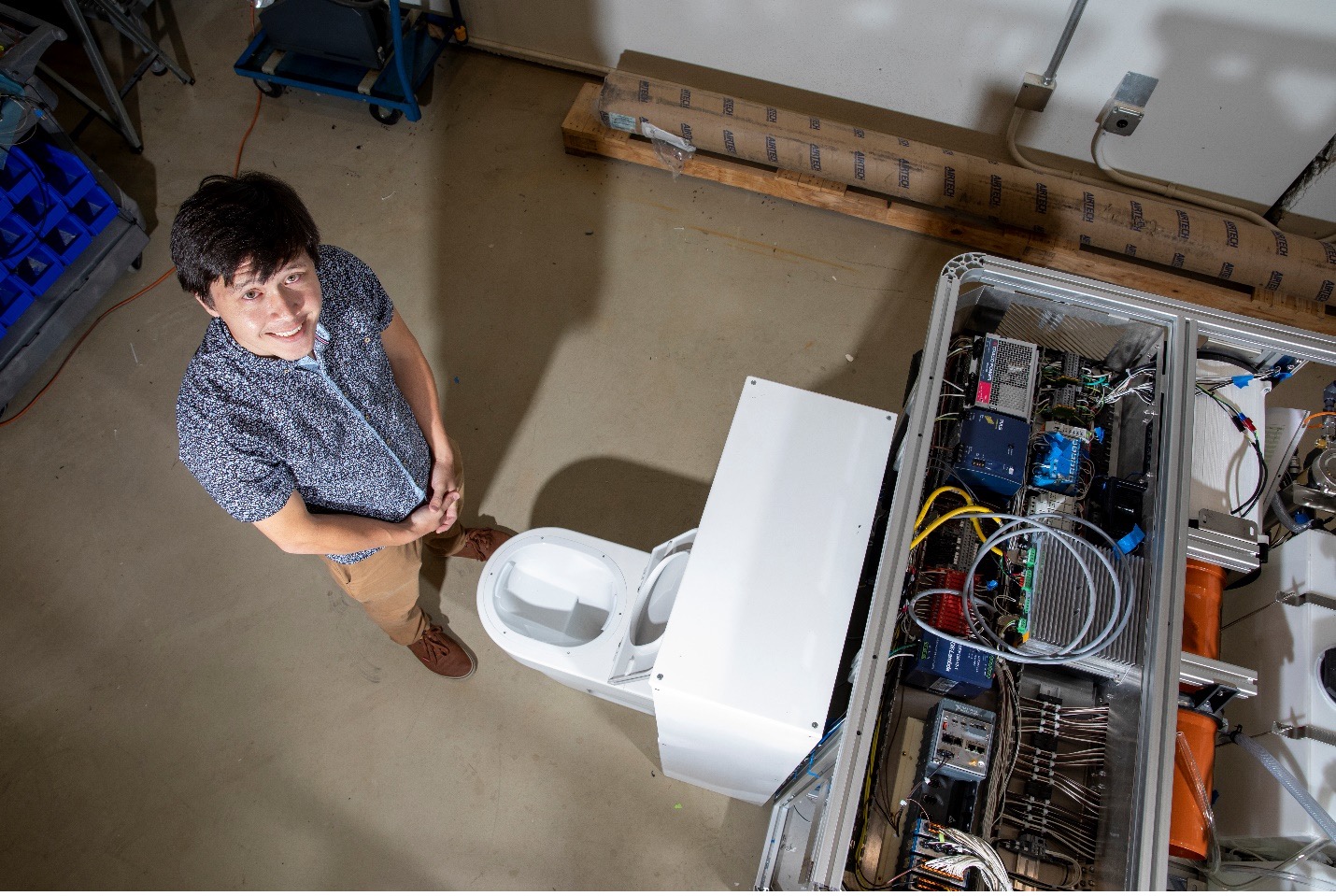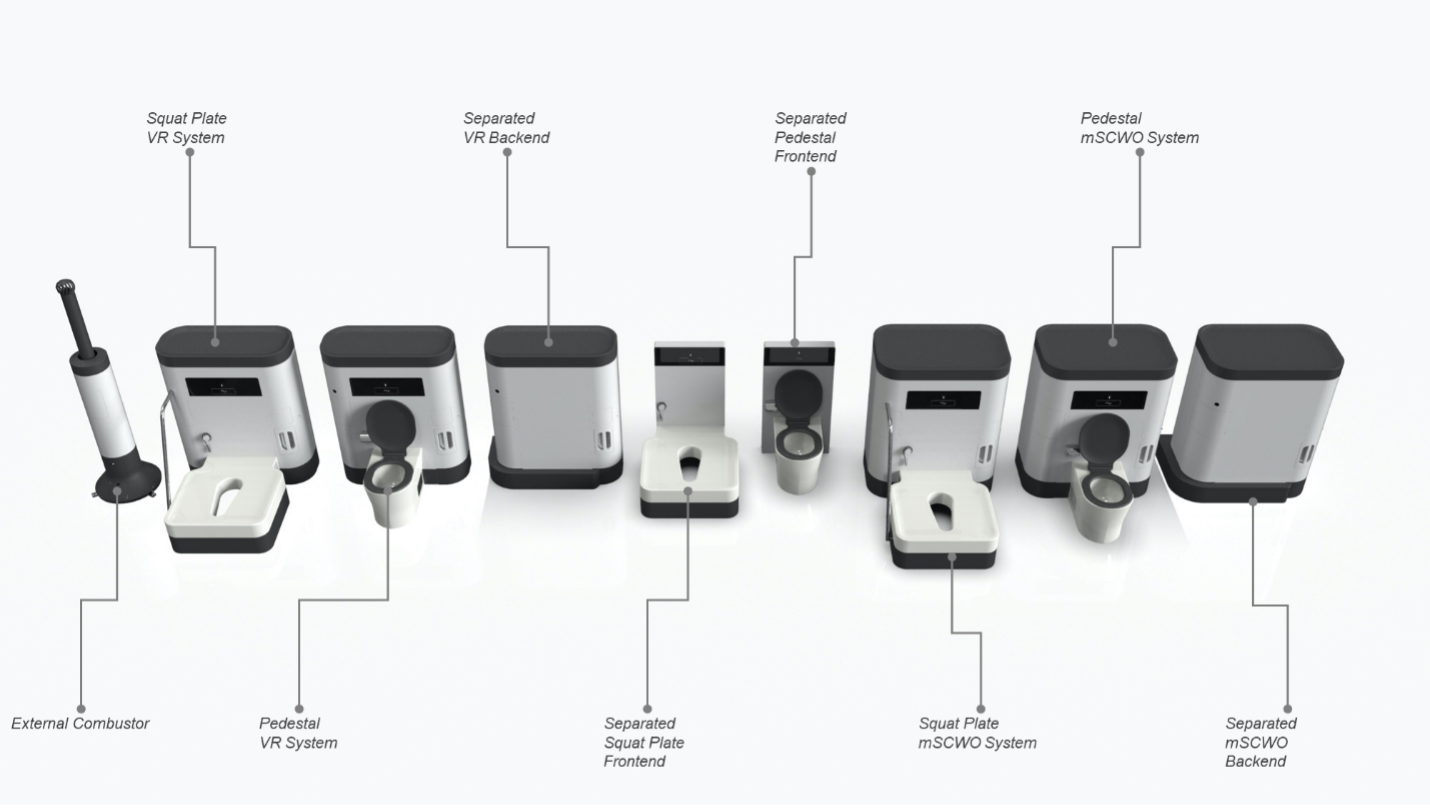This technology is a self-contained toilet sanitation system for the disposal of human waste. It requires no inlet water, plumbing, or output sewerage—rather, it relies on mechanical and thermal processes to kill all pathogens and process human waste. The process results in low-moisture (<30%) feces cakes, which can be used horticulturally, combusted using the optional outdoor combustor, or simply thrown away. This technology is expected to result in a low-cost toilet sanitation system ideal for locations where plumbing and sewerage sanitation facilities do not exist. The system aims to use only 1 kWh of electricity per day, which could easily be powered with one small solar panel.
There are currently three fully functional prototype systems in operation, one of which is on the Georgia Tech campus. Five more updated systems will be coming in the next few months and will be installed in homes, including planned installations in South Africa, India, and China. Throughout 2022, an additional eight systems will be installed around the world for demonstration. To accommodate various bathroom configurations and sizes, there are two models of the system: a single-unit model and a two-unit model that allows for the toilet bowl and the processing unit to be in separate rooms. Both models support sitting or squatting, so there is no need for behavior changes.
This self-contained toilet system consists of six different modules, which are put together to make the complete functional toilet. Further details are provided below (“Background and More Information”) for each of the following modules:
- Method for the separation and transport of human waste from input into a toilet
- Method for the separation, dosing, and homogenization of human waste
- Method for the treatment of human waste under super-critical hydrothermal conditions
- Method for the removal of pathogens and chemical contaminants from liquid human waste using membranes
- Method for the pasteurization and volume reduction of solid human waste
- Method for the outdoor reduction of dried feces to inert ash
- Self-contained: Requires no plumbing or sewerage
- Ecological: Reduces the use of clean drinking water in sewerage processes, as well as the energy and infrastructure required for modern wastewater treatment and disposal
- Forward-looking: Could provide non-sewered locations with a much-needed sanitation solution, while potentially addressing ecological threats (water use, air and waterborne pathogens, etc.)
- Versatile: Accommodates bathroom size with single- and dual-unit models, as well as options for squatting (squat plate) or sitting (pedestal)
While initially intended to provide a low-cost toilet sanitation solution for the developing world and urban markets where plumbing and sewerage sanitation facilities do not exist, there are also potential market opportunities in the developed world. These include places where regional constraints (e.g., rising sea levels) or failing centralized infrastructure need a non-sewer solution, existing self-contained toilet markets (e.g., marine or recreational vehicles), and future “green” markets.
This self-contained toilet system consists of the following modules:
1. Method for the separation and transport of human waste from input into a toilet
This module separates the input human waste from either a urination or defecation toilet event into three streams: 1) urine and trace amounts of flush water (the yellow stream); 2) flush water, toilet paper, and trace amounts of urine (the blue stream); and 3) feces, flush water, urine, and toilet paper (the brown stream).
2. Method for the separation, dosing, and homogenization of human waste
This module is a buffer tank that separates and homogenizes the waste. It consists of a dual chamber tank system for the short-term storage and fractional passive separation of liquid from solid human waste and toilet paper. It is connected to a homogenization component that macerates the solid waste to a uniform particle size and transports the slurry to the other treatment modules for further processing.
3. Method for the treatment of human waste under super critical hydrothermal conditions
This module heats and pressurizes a slurry of human waste to the super critical point of water, killing all pathogens and reducing the complex organic molecules to simple chemical building blocks using a series of batchwise processes. The feces slurry is transported into the module’s injector vessel, where it is pressurized using air. The pressurized slurry batch is then injected into the module’s reactor. The reactor is then heated to the super critical point of water over a period of approximately 2 minutes. The reactor is maintained at this state for approximately 8 minutes. Once complete, the reactor output is ejected into a combined condenser and phase separator, which separates the solid ash from the liquid waste, reduces the volume of the effluent, and recovers energy from the effluent. The solid waste is transported to a disposal bin for removal from the system, and the liquid waste is transported to the urine and wastewater treatment module.
4. Method for the removal of pathogens and chemical contaminants from liquid human waste using membranes
This module removes pathogens and other contaminates from human waste. It consists of a membrane filtration process for the removal of pathogens and chemical contaminants from liquid human waste to produce water suitable for recirculated toilet flushing or safe discharge. The liquid waste (primarily composed of urine, flush water, and trace amounts of toilet paper) will pass through a series of filtration stages including ultra-filtration, nano-filtration, and reverse osmosis. Each filtration stage will have an associated reservoir tank and pump component enabling each filtration to operate at the most effective pressure. The rejected concentrate will be recirculated through the filtration stages before diversion to a concentration process for discharge.
5. Method for the pasteurization and volume reduction of solid human waste
This module performs pasteurization and volume reduction processes for the treatment of human waste in a toilet environment to produce sterile and pathogen-free feces cakes suitable either for combustion and reduction to ash or disposal by other means. The feces slurry is passed into a pasteurization heater where it is held at elevated temperatures until pathogen kill is achieved. The waste slurry is transferred at elevated temperatures to a mechanical dewatering filter press. The slurry is then compressed into a volume reduced solid waste (expecting a 50 to 60% reduction) and ejected from the filter press as a feces cake onto a conveyer. The conveyer transports the feces cakes to the disposal bin over a period of hours. The conveyor is housed in a contained air duct system to enable forced air to be propelled over the cakes to provide evaporative drying of the cakes during transport. The final cakes will have less than 30% moisture content and be deposited in a removable bin for subsequent disposal.
6. Method for the outdoor reduction of dried feces to inert ash
This optional module is a combustion chamber located outside the house and is used for burning the dried feces cakes. It consists of a two-chamber combustion system with an effective air flow for the evaporative drying and combustion of dried, volume-reduced feces cakes and reduction to ash using biofuel sources (paper, twigs, wood) to initiate combustion.
Researchers
Over 70 researchers worldwide from various companies and institutions have contributed to this technology. The Lead PI, representing numerous international innovators, is Shannon Yee.

Dr. Shannon Yee and the reinvented toilet prototype.

Illustration of G2RT (Generation II Reinvented Toilet) Product Portfolio.
